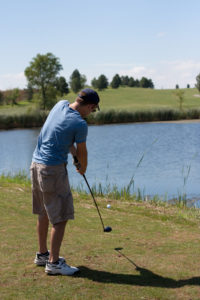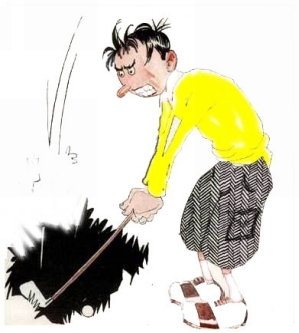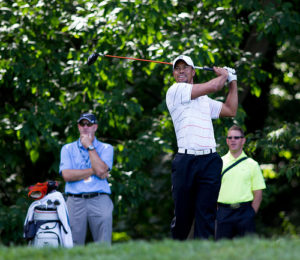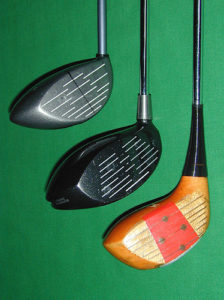Order, Order, Order
Work on the five fundamentals in order: grip, posture, pivot, hand/arm relationship, and then alignment. It’s important to be proficient in each area before you go on to the next. An error in any of the five fundamentals can throw off your entire golf swing.
Pictures and Video
Many golf instructors will video their students when they are swinging. This lets students see their problem areas in their golf swings. Even if you aren’t taking lessons, you can have someone take a video of you while you are practicing your swing, or you can set it up on a tripod and do it all by yourself. Many times, seeing your golf swing on video will quickly clarify your weak areas and pinpoint what you need to work on. Video is a very effective tool for beginning golfers who can’t figure out what they are doing wrong.
Which Club to Use?
Beginning golfers often are confused over golf clubs. They don’t know when to use what club. To put it simply, each golf club is made so it will affect the ball differently. Some clubs will make your ball go far, others will help you get out of a bunker or rough area, or help you get the ball into the hole.
The only way you’ll learn which club to use is to practice and to use educated guesses based on your previous practices. To begin, go to a driving range and start gauging how far your ball goes with different clubs. Over time you’ll be able to make good decisions about which club will suit your goal—and the yardage possibilities of each club will be second nature to you.
To help take some of the mystery out of golf clubs you should know that the higher the club number, the more lift the club will have and the shaft will be shorter. These shorter clubs that have more “loft” will make balls go a shorter distance than a longer club that has less lift.
Suffice it to say, the low numbered clubs will have less loft and they are generally used for line drives. Higher numbered clubs that have more loft are used when you don’t want your ball to go too far.
As far as where you position the ball, it will depend on which club you are using. As a general rule, as the loft of the club decreases—and the club number goes down—you should place the ball father up into your stance and closer to your front foot. When hitting woods, you’ll want the ball position just inside where your left heel is located.
Let’s say you want to hit a low shot. In this case, you will want to move the ball back a bit further in your stance. If you want to hit a high shot, move the ball forward.
Swinging Tips
- One of the most important things you can remember about golf is that it’s not really an arm and wrist game. The power in your swing will come from your legs and your trunk.
- You will have to ignore the natural feeling of wanting to look away from the ball when you begin to pull your club back. Keep your eye on the ball at all times during your swing. If you don’t, you increase the chance that you won’t make contact with it.
- Never turn your head, or look up, before your swing is complete to see where the ball goals. Don’t raise your head until you are certain you have made contact with the ball.
- Come up with something you say to yourself each and every time you step up to swing that will help you focus on the ball. Even something such as, “I’m really focusing on this ball” can help you focus.
- Your goal is to swing through the ball, not swing at the ball. Complete your stroke; don’t stop your stroke after you’ve made contact with the ball.
- Many golfers will drop their right shoulder after they’ve struck the ball. This is not good. A proficient golf swing does not stop after impact, it continues. Once you learn to swing through your stroke, so that your shoulder is past the ball and your left foot, you’ll see your distance increase.
- An exercise that will help teach you to swing through the ball is to place a tee in the ground about six to eight inches in front of the ball. Try to not only hit your ball, but also the tee in front of it.
- Don’t swing too hard at the ball. All a hard swing does is prove that you have strength, but accuracy is the name of the game. Going the distance comes from accurate swinging, not power shots.
- If you find yourself swinging too hard, it may be that you are too tense. If you relax a bit you’ll probably find that you won’t swing as hard. Putting your feet a bit closer together can also help reduce your power. After you’ve mastered the mechanics and accuracy of your swing, you can then hit the ball harder.
- To keep your center of gravity during your golf swing, keep your feet in the same position throughout your swing—in other words don’t take your feet entirely off the ground and place them back down. Also, when your club makes contact with your ball your feet should be firmly planted on the ground.
- Feel every part of your swing. If you notice that you are tensing up right before your club makes contact with the ball it can result in your balance being thrown off—which results in your club head not remaining in a straight line as it comes down.
- If you are slicing your shots, you are not hitting with the center of your club. Practice your swing until you get proficient at centering the club head.
- It’s not crucial that your left arm stay absolutely straight throughout your backswing; you can bend it slightly, just make sure it’s straight when your club comes down and you strike the ball.
- If your practice swings are good and your real swings are off, the chances are high that you are failing to “feel” your swing when you step up to the ball. Beginning golfers often psych themselves up when they step up to the ball and they forget how to feel the swing because they are concentrating on where they want the ball to go, how hard they should hit the ball, etc. Try to approach your real shots with the same relaxation and awareness you experience with your practice swings.
- Avoid watching beginning golfers swing and try to watch as many good players as possible. You’d be surprised how what we see can become part of what we do. Imitation is often done unconsciously, so avoid focusing on how beginning golfers swing so those images aren’t in your mind.
- Avoid golf swing advice from beginning golfers.
- When you do practice, focus on what you’re doing. It’s better to spend 15 minutes of focused practice than an hour of goofing off. Also, take breaks when you need to. No one swings very well when they are frustrated or tired.
- Avoid sunglasses as they can impair your depth perception. This is why you see so many professional golfers wearing hats or sun visors instead of sunglasses.
- A lighter grip will get your ball farther than a tight grip because a tight grip generally means the muscles are tense.
Remember that the golf course is the place to play golf, not practice or work on your golf fundamentals. Practice your fundamentals at driving ranges and at home.









 Every golfer will find himself in a bunker at one time or another. When your ball ends up there, and believe me it will, don’t freak out. Bunker shots are really not hard if you remember these tips:
Every golfer will find himself in a bunker at one time or another. When your ball ends up there, and believe me it will, don’t freak out. Bunker shots are really not hard if you remember these tips:
